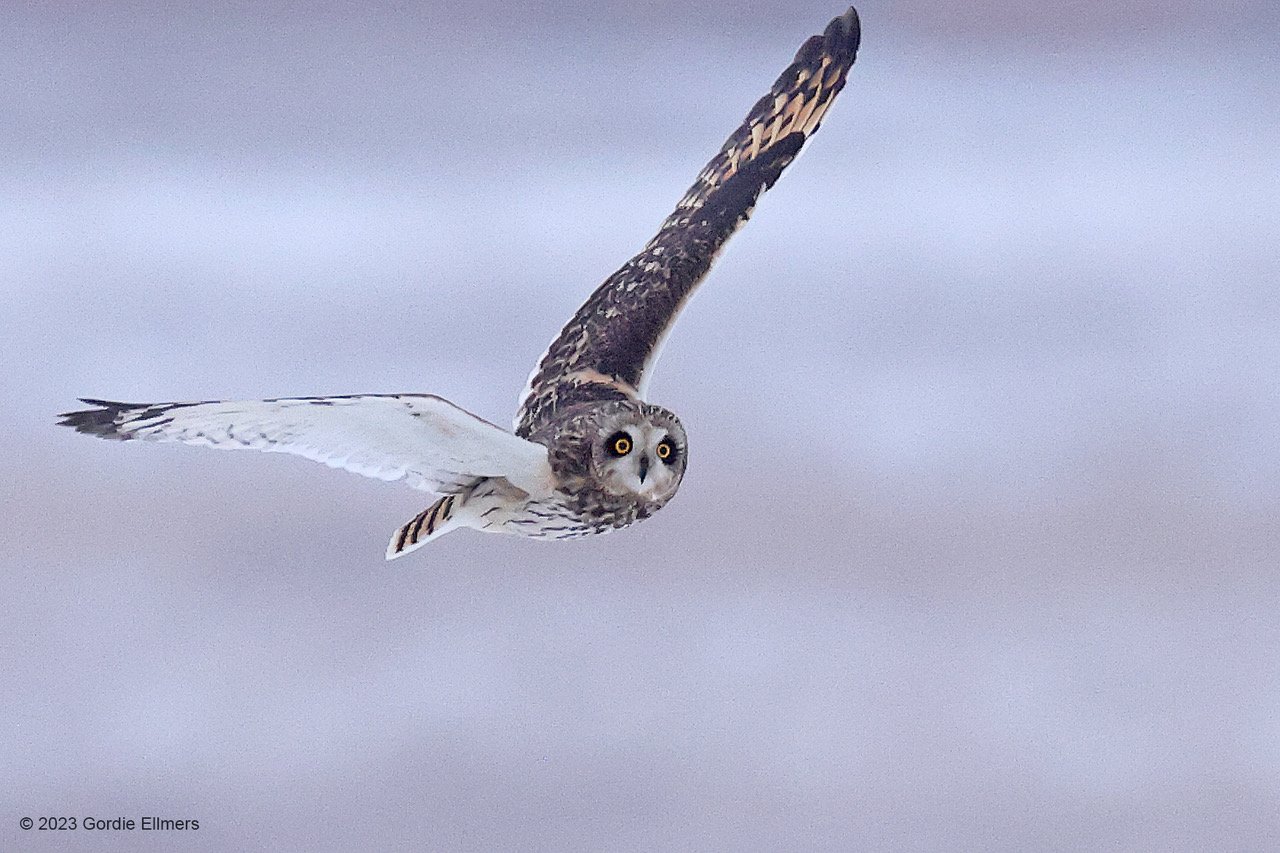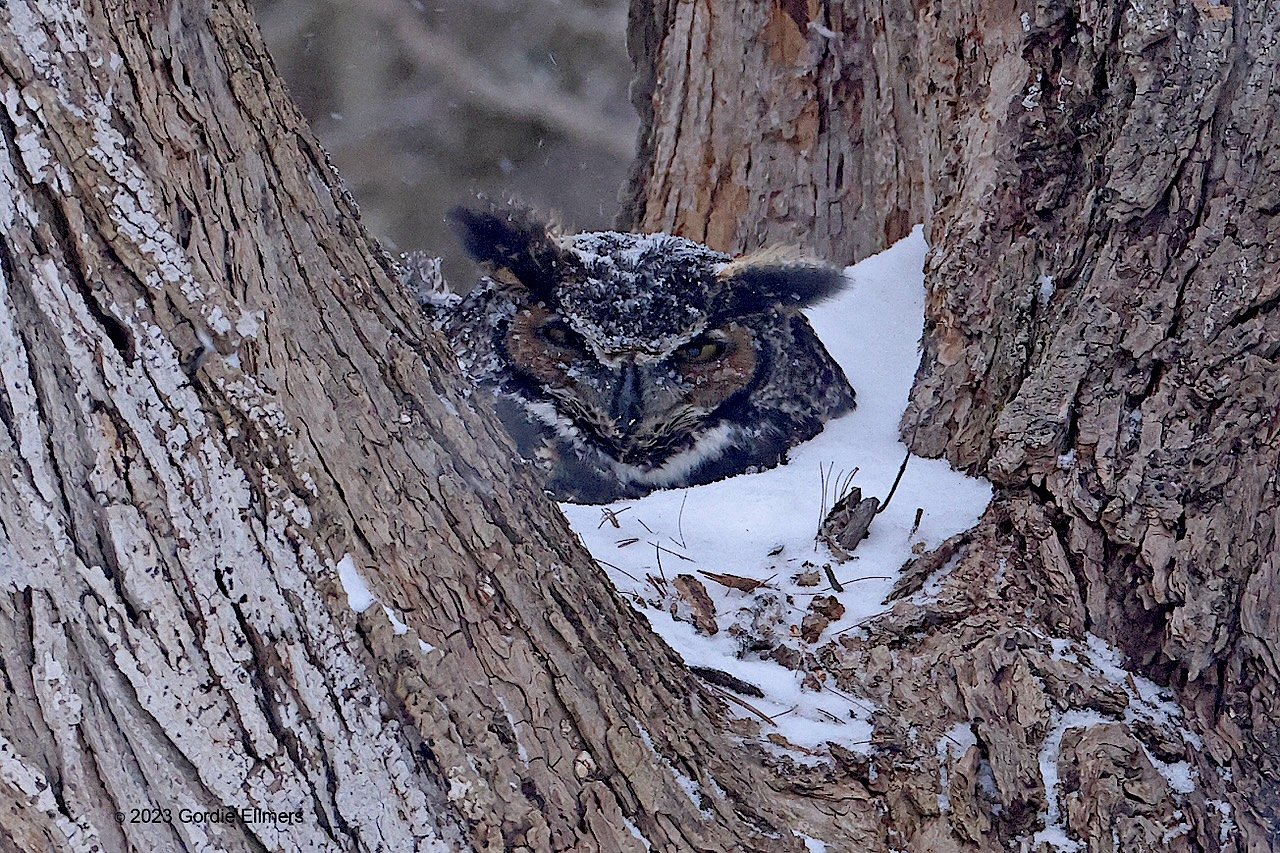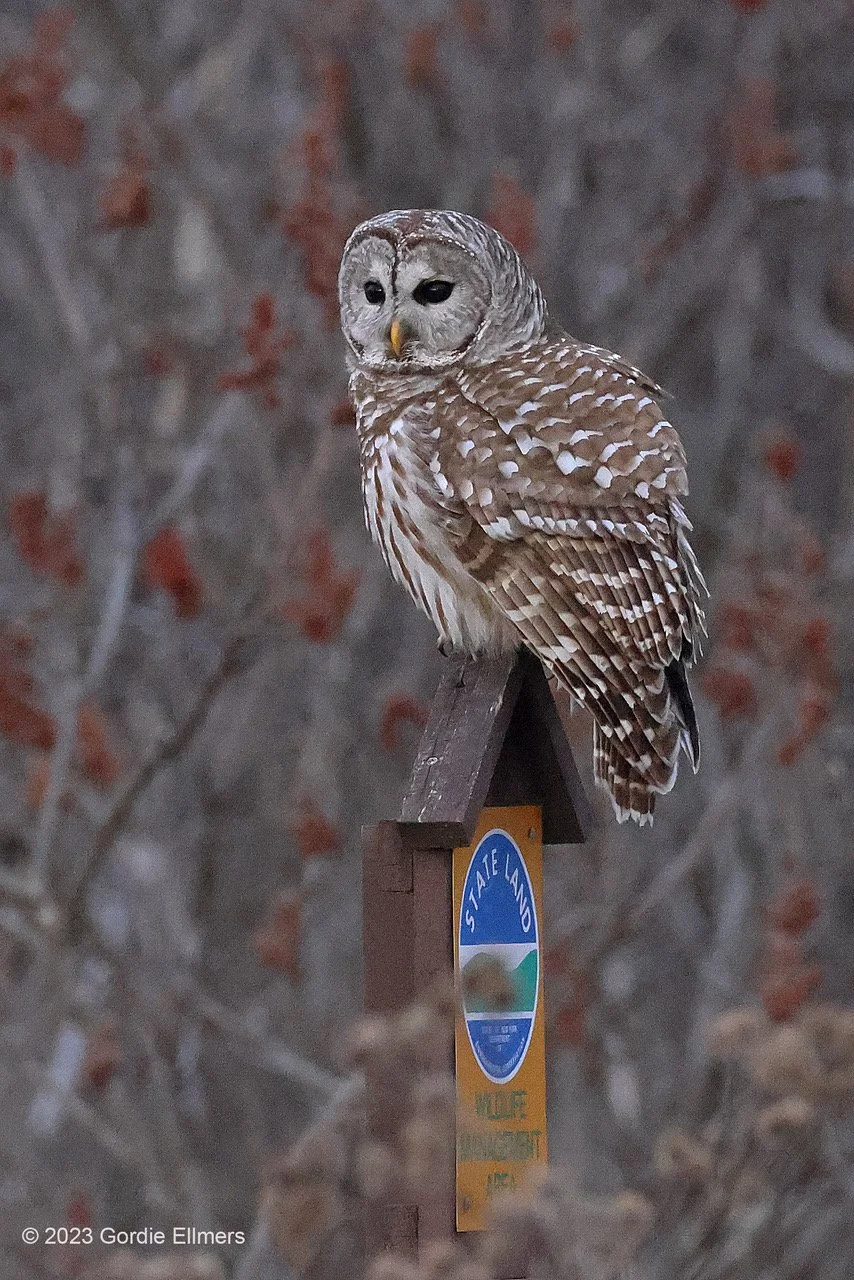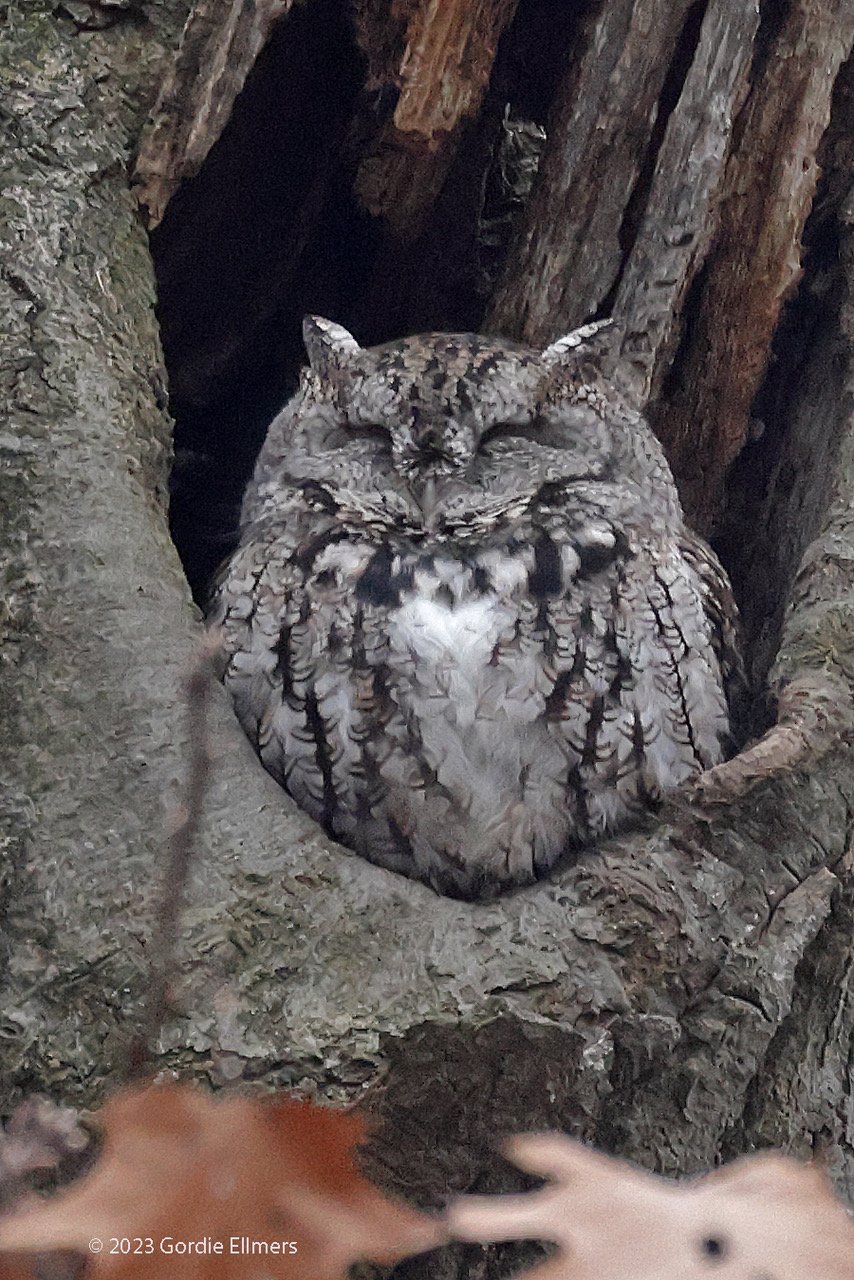Eight Audacious Owls of North American and Where to Look For Them
Roberta Kravette, Destination; Wildlife co-founder and bird lover.
Owls! Mysterious and iconic, these birds don't need bright plumage or intricate songs to impress.
Many are night hunters, napping out the days hidden in plain sight, but as dusk replaces bright and the world slows to sleep, owls come alive, spreading their great wings and assuming their reign. The night belongs to these owls.
Still, a few, like the Snowy, own the twilight hours, hunting at dawn and dusk. With brilliant eyes and soundless flight, these excellent predators have been the stuff of legends and myths since humans lived in caves. Worldwide there are over 200 owl species, but only 19 live in the United States. These are eight of my favorites.
1. The Spotted Owl - the Small Bird with a BIG Impact
The Northern Spotted owl, the small, unassuming owl that inspired a movement, and is still helping to shape opinion and ideas. Image: ©Reese Ferrier
The Spotted Owl may not be the most charismatic or beautiful owl species, but for many of us old enough to remember, the Spotted Owl controversy of the late 1980s and early '90s was our call to environmental activism.
Images of people in Washington State chained to old-growth trees, ready and willing to be arrested for this bird, made headlines around the world - and a lasting impact on me.
The Owl That Inspired a Movement
Spotted Owl range map thanks to CornellLab, All About Birds
Spotted Owl Fast Facts
Strix occidentalis
✓ IUNC: Near Threatened, declining.
✓Length: 18.5-18.9in (47-48 cm)
✓Weight: 17.6-24.7 oz (500-700g)
✓Wingspan: 39.8 in (101cm)
✓ Eyes: Brown
✓ Durinal hunter
The Spotted Owl protest that began in the Northwest spurred the debate on the importance of protecting old-growth forests. It also pit saving the environment and birds against human employment. Although a compromise was reached and some logging continued, many loggers were suddenly out of work.
Change is never easy. Forty years later, old-growth logging is still a contentious issue, and the Spotted Owls (all three species) are still in decline - as are logging jobs, but neither humans nor owls are as yet extinct, and new renewable industry jobs are replacing those of the old extractives. There is hope for humans, spotted owls, and old-growth forests. And we have the little Spotted Owl and the people who stood up - and chained up - to thank.
Challenges for Spotted Owls
Once again, the Spotted Owl is at the center of controversy. Recently, the Barred Owl’s range has extended into much of the Spotted Owl's diminished territory, and they are interbreeding. In an attempt to save the Spotted Owl, The US Fish and Wildlife Service hatched a controversial plan to kill almost half a million Barred Owls in Oregon, Washington, and California over the next couple of decades. Conservationists are fighting on both sides of the controversy.
Best Place to Look for a Spotted Owl:
Look for them in the Boreal forests of Washington State, Oregon, and Northern California (spruce, balsam fir, aspen poplar, and birch trees) and Muir Woods National Monument, and the Douglas fir forests of Point Reyes National Sea Shore in California.
2. The Snowy Owl
Snowy Owl “shops” the Grassland Bird Trust fields in Fort Edward, New York. Note the dark details, this is probably a female or a young bird. The Very white Snowy owls are male. Image: ©Gordon Ellmers
Snowies breed in the extreme north (orange) Range map thanks to Cornellabs All About Birds
These gorgeous big birds, the second largest owls in North America, with their gleaming white feathers and striking gold eyes, are recognizable and super-exciting to everyone from life listers to Harry Potter fans.
Snowy Owl Fast Facts
Bubo scandiacus
IUNC: Vulnerable, decreasing
✓ Length: 20.5-27.9in (53-71cn)
✓ Weight: 56.4 - 104.1oz (1600-2950 g)
✓ Wingspan: 49.6-57.1in (126-145cm)
✓ Eyes: Gold
✓ When to look? Dawn and dusk
Snowy fever seems to ignite wherever these shy birds are spotted. Project SNOWstorm founder Scott Weidensaul summed up their appeal, "It's hard to find anyone ambivalent about snowy owls." And since they tend to hunt at dawn and dusk - their sudden appearance in winter brings humans running!
Snowies breed in the Arctic above the tree line, scraping out a shallow nest on tundra hard with permafrost and rock. The storied birds feed their chicks on a diet of that equally storied rodent – the lemming.
Our chances of seeing a Snowy Owl depend greatly on the Arctic lemming population. More lemmings mean more snowy owls born and surviving to migrate south, gliding in on a cold winter's night and suddenly (magically!) appearing in our open frozen fields, on a telephone pole or a wintery sand dune, or (unfortunately) on airport runways. Note: You can follow Snowy Owl migration with Project SNOWstorm.
Challenges for Snowy Owls
Disappearing permafrost due to climate change and other habitat degradation is having a negative impact on Snowy Owls - and lemmings. Rodenticide also takes a toll. According to Project SNOWstorm, a recent decade-long study revealed that 68 of 196 dead Snowy owls studied had high levels of rat poison in their bodies, many enough to cause internal hemorrhaging. Car strikes and exhaustion from love-caused flushing - all contribute to mortality.
The Best Place to Look for Snowy Owls:
During winter, Snowy owls migrate to southern Canada and the northern US. Look along the coastlines, in the dunes, or on fenceposts, telephone poles, and barn roofs near open fields. Upper New York State, the Great Lakes region, Minnesota, and the New Jersey shore are historically good winter snowy countries.
3. Great Grey Owl - North America’s Largest Owl
Seeing a Great Grey, especially with a chick, is an unforgettable experience. The Great Grey Owl has been on California’s state Endangered list for more than 30 years. Image: ©Robin Eriksson
The third largest owl on the planet (only the Blakiston and the Eurasian Eagle-owl are bigger) and one of the most powerful in the Northern Hemisphere, the Great Grey owl lives up to its name. However, this magnificent bird is - mostly feathers! The smaller Great Horned and the Snowy both out-weigh our Great Grey and both owls have larger feet and talons.
The Great Grey Owl (non-migratory) range thanks to CornelLab All About Birds
Great Grey Fast Facts
Strix nebulosa
IUNC – Least Concern, for now
✓ Length: 24-33 in (61-84 cm)
✓ Weight: 24.7-60lbs (700-1700gm)
✓ Wing Span: 53.9-60.2in (137-153 cm)
✓ Night hunter, and dawn and dusk
Still, this is a very impressive raptor. The Great Grey Owl lives in northern boreal forests (taiga) across North America and Russia. The elusive predator tends to stay away from people but might be found silently and almost invisibly perched where the fir and pine trees are dense, near a meadow, or at the edges of forests.
Great Grey owls need to consume the equivalent of seven voles a day. Snow-covered ground is no problem. Their excellent hearing allows them to detect movement under the snow. When they do, they hover until the time is right, then drop - talons first - to grab their prey.
Challenges for the Great Grey Owl:
This bird likes it cool—and so do the forests it inhabits. Logging and degradation from global warming are negatively impacting its boreal forest habitat. The long-term health of the boreal forests could determine how these and other boreal owls survive. The Great Grey sometimes dies of starvation, as they require a lot of food but do not have enough body mass to carry off larger prey. Car strikes, and even being hunted are also threats.
The Best Place to Look for Great Grey Owls
Minnesota’s boreal forest in winter, especially the Northeast along Lake Superior, Superior National Forest.
4. Northern Hawk Owl
Northern Hawk owl grabs lunch! A magnificent capture by ©Josh Galiki for NatureScape Tours
The Northern Hawk-Owl’s range thanks to CornelLabs All About Birds
In the ancient boreal forests of northern Canada, Alaska, and Siberia, the tallest trees shelter a strange solitary bird that looks like an owl but hunts like a hawk
Northern Hawk Owl Fast Facts
Surnia ulula
IUNC: Least Concern.
✓ Length: 14.2 - 17.7 in (36-45 cm)
✓ Weight: 8.5-16.0 oz (240-454g)
✓ Wingspan: 27.9in (71cm)
✓ Eyes: Gold
✓ Daytime hunter
The solitary (except for breeding time) Northern Hawk owl is a mostly daytime predator; sitting quietly on a tree branch, watching and listening for unwary little mammals on the ground or under the snow. They cache extra food in tree crevices.
Much of their home range is not easy to visit, but if you are lucky enough to get there, the Northern Hawl-owl does not make your sighting especially difficult. They are not afraid of humans—perhaps because humans were a rare sight in these forests. Or perhaps it was because the humans who shared the forest revered and respected this bird with its owl face and hawk-like tail.
Challenges for Northern Hawk Owls
Their Boreal forest habitats are being razed at a rate of 5 NFL hockey rinks a minute. Much of the wood taken from them is used to make toilet paper and paper towels, mostly for US consumption. The oil, gas, and mining industries also contribute to boreal forest destruction as does climate change.
Best Place to Look for Northern Hawk-owls
Minnesota’s boreal forest in winter, especially the Northeast along Lake Superior, Superior National Forest, and forests in Aiken, Cook, Lake, and St. Luis counties.
5. The Short-eared Owl
I could watch Short-eared owls for hours! As long as you keep your distance and keep quiet, they are not shy about having their pictures taken while they are hunting. Image: ©Gordon Ellmers
I'm not a "spot-it / list-it" kind of birder. I love to watch birds live; sometimes they are pure elegance, other times little comedians - but always fascinating. Birds can be acrobats or lumbering, serious or almost silly; short-eared owls display it all.
“Shortie” range: Orange - breeding, Blue - wintering, Purple - all year. Short-eared oWl range map thanks to CornelLabs All About Birds
Short-eared Owl Fast Facts
Asio flammeus
IUNC: Least concern but in steep decline
NY State: Endangered
✓ Length: 13.4-16.9in (34-43cm)
✓ Weight: 7.3-18.8 oz (206-475g)
✓ Wingspan:33.5-40.5in (85-103cm)
✓ Eyes Color: Gold
✓ Hunt: Mostly dawn and dusk.
The little owls are daylight hunters, usually in the early morning or near dusk, darting, gliding, zig-zagging across open fields looking for small mammals. And because they tend to roost together in the winter, if you find one "shortie," you have probably discovered a few; when that happens, it is time to relax and enjoy the show!
My Favorite “Shortie” Memory
It was a cold, grey February afternoon on Amelia Island, Canada, day three of a winter birding week on the shores of Lake Ontario, and so far, it had rained—no, poured—every day. By 3 PM, our small group was headed back to the ferry to the mainland, damp and cold, and looking forward to a hot shower.
Waterfowl was not bothered by the inclement weather, and we'd seen plenty but few of the raptors we'd hoped for – until someone spotted movement in an open field. We stopped. So did the rain.
Soft light broke through the clouds, and suddenly, the field was alive with Shorties! They seemed almost to be playing or perhaps celebrating the break in the weather, gliding over the field, bobbing and weaving, disappearing into the old grass, then popping up and soaring again. We stood enthralled.The soft light slowly faded into the evening. Finally, it was time to leave; any memory of the cold and dampness was erased by the glow caused by fourteen Short-eared owls in a half-frozen field.
We are still learning about shorties, but it's thought that most populations migrate. They breed mostly in Canada, Alaska, Scandinavia, and Siberia, nesting on tundra, grasslands, and open fields, and then migrate south again to winter in the US, Europe, and parts of Asia. They are one of the only owls to build their own nest.
Challenges for Short-eared Owls
The Short-eared owl is one of the most widespread owl species, but it is also one of the fastest-declining and is already listed as Endangered in New York state. According to CornellLabs, “Shorties” require large tracts of open grassland and are particularly sensitive to habitat loss and fragmentation from agriculture, livestock grazing, development, and recreation.
Best Place to Look for Short-eared owls:
New York State. Head up to the Fort Edward area and the fields of the Grassland Bird Trust (join us for our 3-day winter weekend or weekday tour with the GBT!), or keep going north across the border and take the ferry to Amelia Island, Canada. And Minnesota’s boreal forests in winter.
6. Burrowing Owl - The Howdy Bird!
They bob and “dance” and seem like the clowns of the owl world, but Burrowing owls are loosing ground - literally. Image: ©Rinus Baak
What is 7 to 9 inches tall, lives underground (they have a higher tolerance to carbon monoxide than most birds,) is the only owl to hunt day and night, and were nick-named by cowboys for their unusual bobbing "welcome"? It's that Howdy-bird, the Burrowing owl.
Orange - Breeding, Blue - winter, Purple - wll year. Burrowing Owl range map thanks to CornelLabs All About Birds
Burrowing Owl Fast Facts
Athene cunicularia IUNC – Least Concern
✓ Length: 7.5-9.8in (12-25cm)
✓ Weight: 5.3oz (150g)
✓ Wingspan: 21.6in (55cm)
✓ Eyes Color: Gold
✓ Hunt: Daytime
This unusual little owl lives in deserts, grasslands, and open, treeless areas, including agricultural fields and pastureland, even the grassy meridians of airports and roads, where they feed on insects, lizards, and small mammals.
Breeding pairs stay close together forming loose colonies in areas with other burrowing mammals like prairie dogs, ground squirrels, skunks, marmots, and tortoises. Both members of the mostly monogamous pair "renovate" burrows confiscated from their mammal neighbors by using their beaks and feet to kick out dirt to enlarge them.
They line the nests with feathers, grass, etc., and sometimes create a livestock manure welcome mat at the entrance. Beetles and other insects attracted by manure make feeding the Burrowing owl’s chicks a little easier. They also cache extra mice. In Florida and the Caribbean, Burrowing owls excavate their burrows.
Burrowing Owls hunt day and night, walking or running over the ground, or flying or hovering close to it. And they are famous for the little "dance" they do, bobbing up and down when disturbed or when hunting to pinpoint prey.
Challenges for Burrowing Owls:
Burrowing Owls are losing ground at a rate of about 4% per year. Habitat loss from development and agriculture, predation by domestic cats and dogs, pesticides, shootings, and vehicle collisions all contribute to the decline. The decline of prairie dog populations (and their burrows) due to the same factors exasperates their situation. The losses have been particularly steep in areas including Florida, the Midwest, the Dakotas, and California. In 1975, the Burrowing owl was considered almost ubiquitous in Southern California; today, the population has decreased by 60%.
Best Place to See a Burrowing Owl
Burrowing owls can be found in the Grasslands National Park in Saskatchewan in the summer, in the winter in Texas' panhandle, and all year in Arizona's Maricopa county south of Phoenix.
7. Northern Saw-whet Owl
The Northern Saw-whet owl’s face is cat-like, and at only 7 - 8.1 inches (17.8-20.3 cm) , they are the smallest North American owls. Image: ©Megan Lorenz
One of the smallest – and cutest – owls in North America is the Saw-whet. But don't let its size and continence fool you – to its prey, including other birds, small mammals, especially deer mice, and insects, this tiny forest owl is a fierce nocturnal hunter.
Purple is year-round, Blue is winter. Northern Saw-Whet range map thanks to CornelLabs All About Birds
Northern Saw-Whet Owl Fast Facts
✓ Aegolius acadicus
✓ IUNC: Least Concern
✓ Length: 7.1-8.3in (18-21 cm)
✓ Weight: 2.3-5.3oz (65-151g)
✓ Wingspan: 16.5-18.9 in (42-48cm)
✓ Eyes Color: Gold
✓ Hunt: Nocturnal!
They inhabit forests across the US year-round, but northern Saw-whets are migrators, able to fly across the Great Lakes and stretches of ocean. But don't expect to readily see one. The Northern Saw-whets are experts at disappearing into their surroundings – until a songbird discovers one, calls in reinforcements, and mayhem ensues! The “gang” will make a huge racket, harassing the owl until it moves on.
Saw-whet Parents Have Somewhat Different Priorities
The Saw-whet pairs both parents raise the young - but have very different styles! The female incubates the eggs in a dead tree hole previously excavated by a large woodpecker like a Northern Flicker or Piliated. The male brings food and "mama" stays with the chicks and keeps the nest very clean and free of debris. But in 2 weeks or less, she leaves, usually never to return. The male will stay another month or so, feeding the chicks but allowing the once-tidy nest to quickly fill up with a thick layer of pellets, feces, and discarded prey parts. Hmmm.
How small is a Saw-Whet owl? This (rescued and rehabed) ambassador Northern Saw-whet at the Grassland Bird Trust’s Winter Raptor fest fits in the hand of its handler. Image: ©Gordon Ellmers
Fun Fact: Saw-whet owls may have gotten their names from their call, which people thought sounded like a blade being “whet” or sharpened.
Challenges for Northern Saw-whet Owls
Saw-whets have a wide range but seek out mature forests, which is problematic as logging removes habitat. North Carolina and South Dakota have listed them as "special concern," and on the islands of Queen Charlotte, British Colombia, they are listed as a native subspecies is listed as threatened.
Best Place to See Northern Saw-whet Owls
Minnesota’s boreal forest in winter, especially the Northeast along Lake Superior, Superior National forest. They like thick cover, and Sharon Stiteler says in her Audubon article, “I rarely find small owls higher than 10 feet up”
8. The Great Horned Owl
Great Horned Owl, the male of the breeding pair in the Grassland Bird Trust area in Fort Edward, New York. Image Thanks to ©Gordon Ellmers.
With its great "ear" tufts, piercing eyes, and impressive size, this owl is the stuff of stories and legends.
The Great Horned Owl range map: Purple - all year. Range map thanks to CornelLabs All About Birds
The Great Horned Owl is the fifth biggest owl in the world and the third largest in North America; only Great Grey and Snowy are larger, but not by much! And although it is the most common owl in the US, it is a thrill to see it every time. The Great Horned Owl is a regal bird.
The Great Horned Culinary Preference? Anything that Moves!
Great Horned Owl Fast Facts
✓ Bubo virginianus
✓ IUNC: Least Concern
✓ Length: 24-33in (61-84 cm)
✓ Weight: 24.7-60 oz (700-1700 g)
✓ Wingspan: 54-60.2in (137-153 cm)
✓ Eyes Color: Gold
✓ Hunt: Night, dawn and dusk
The mighty Great Horned has no natural predators and will devour almost anything that moves, including rabbits, skunks, squirrels, rats, and frogs. Great Horned owls are known to hunt and eat animals larger and heavier than themselves, including bobcats and opossums. They eat other birds, like hawks, Peregrine falcons, smaller owls and pheasants, gulls, pigeons, and ducks. They will eat eels, crayfish, catfish, and other fish but will not pass up insects, including scorpions. And Great horned owls are an excellent reason to keep your family cat and small dog safely inside the house.
Like other owls, they devour their prey fur, bones, and all–ejecting (vomiting) pellets of indigestible parts once a day. Finding pellets under a tree is a good clue that an owl is roosting above your head.
The amazingly adaptable Great Horned Owls live in habitats as diverse as desert, forest, wetlands, and grasslands, and range from northern Canada to southern Brazil and Northern Argentina and even in cities and urban areas.
Injured Eye Does Not Stop My Favorite Great Horned Owl Pair
And Great Horned owls are monogamous. One of my favorite sightings is in upstate New York near Fort Edward and the Grassland Bird Trust. The male is a handsome fellow, but the female is blind in one eye, probably injured by a prey animal. One eye does not stop this mighty bird; she has successfully raised broods since the accident.
Challenges for Great Horned Owls
The population of these adaptable birds has been fairly stable since their hunting was outlawed in the mid-twentieth century. Until about 1966, some states paid a bounty on certain wildlife, including Great Horned owls. Between 1913 and 1965 when the bounty was lifted, Pennsylvania paid $5.00 per owl for over 26,608 dead Great Horned owls. Goshawks also had a bounty on their heads.
As with all birds, habitat loss is a challenge, but Great Horned Owls are adaptable and so far are doing well.
Best Place to see Great Horned Owls:
Upstate New York, near Fort Edward, The Grassland Bird Trust, is my favorite place to watch for Great Horned Owls. The winter tours with the Grassland Bird Trust usually inspire some great pictures.
I Could Go On Forever About Owls!
I could go on forever about owls, but those are my favorite – at least for today. Of course, the lovely Barred and the little Boreal owls are two more favorites – and then there's the striking Barn owl with that magnificent face and boisterous Screech owls, and … well, I guess they are for the next list.

























